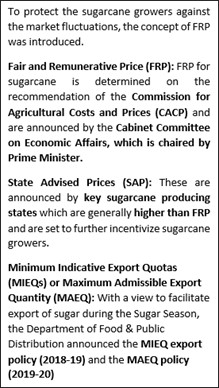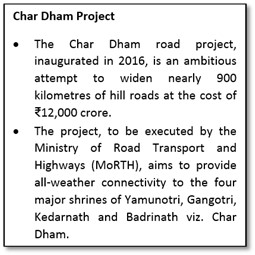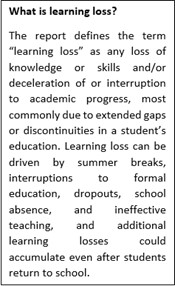Monday, 20th December 2021
Algo Trading
In News
SEBI has released a consultation paper on algorithmic trading, or algo trading.
What is Algo Trading?
- The algo trading system (Algorithmic trading or automated trading or black-box trading) automatically monitors the live stock prices and initiates an order when the given criteria are met. This frees the trader from having to monitor live stock prices and initiate manual order placement.
- In essence, it is the process of using computers programmed to trade in order to generate profits at a speed and frequency that is impossible for a human trader.
Current provisions for the use of Algo trading in India
- The facility of algo trading shall be provided by the stock broker after obtaining permission of the stock exchange where the broker servers are located in India and the stock exchange should have appropriate risk controls mechanism.
- All algo orders shall be tagged with a unique identifier provided by the stock exchange.
- The stock exchange should be in a position to shut down the broker’s terminal when needed.
What are the concerns of SEBI?
- Many brokers in India have started providing Application Programming Interface (API) access to their clients which establishes an online connection between a data provider (stock broker) and an end-user (client).
- For the algos deployed by retail investors using APIs, neither exchanges nor brokers are able to identify if the particular trade emanating from API link is an algo or a non-algo trade.
- This unregulated or unapproved algos pose a risk to the market and can be misused for systematic market manipulation as well to lure the retail investors by guaranteeing them higher returns. The potential loss in case of failed algo strategy is huge for the retail investors.
- Since these third-party algo providers/vendors are unregulated, there is also no investor grievance redressal mechanism in place.

Proposals of SEBI
Sebi has proposed a regulatory framework for algo trading in its consultation paper.
- All orders emanating from an API should be treated as an algo order and be subject to control by stock broker.
- Stock broker needs to take approval of all algos from the exchange. Each algo strategy, whether used by broker or client, has to be approved by exchange and as is the current practice, be certified by Certified Information Systems Auditor (CISA)/ Diploma in Information System Audit (DISA) auditors.
- Stock exchanges have to develop a system to ensure that only those algos which are approved by the exchange and having unique algo ID provided by the Exchange are being deployed.
- Stock brokers need to have adequate checks in place so that the algo performs in a controlled manner.
- Two factor authentication should be built in every such system which provides access to an investor for any API/algo trade.
What are the Market Concerns regarding the proposals?
- Increase in cost of compliance: Sebi’s paper reinforces the rule that all algos need to be approved by the exchange and has labelled all application programme interfaces (API) as algo. All this may increase the cost of compliance. For e.g., if there is a slight tweak in the algo strategy and a trader wants to change the price level to exit a particular stock, even that will require exchange approval.
- Intellectual property (IP) may be compromised: Third-party tech platforms and traders will need to share their algo and APIs with brokers for approvals. Hence, there is a possibility some brokerages could replicate the algo strategy. This can compromise tech firms’ IP.
- Impact on development of the market: As getting the requisite permission from the stock exchanges is a tedious process, brokers may have to stop using the API system. Thus, putting restrictions may impact development of the market.
Sources:
Mental Disability in India
In News
The Supreme Court has held that the Initiation of disciplinary proceedings against persons with mental disabilities facet of indirect discrimination.
The court held that persons suffer a disproportionate disadvantage due to the impairment and are more likely to be subjected to disciplinary proceedings.
What is Mental Disability?
- Mental disability, also called mental health disorders, refers to a wide range of mental health conditions — disorders that affect your mood, thinking and behaviour.
- It impairs the ability of persons to comply with workplace standards in comparison to their able-bodied counterparts.
- About 10% of the population in the world has some form of mental disability, and 1% has severe form of mental disorders with disability.
- According to census 2011, nearly 21% of the population has some form of disability and among them, only 2.7% has mental illness, and 5.6% has mental retardation.
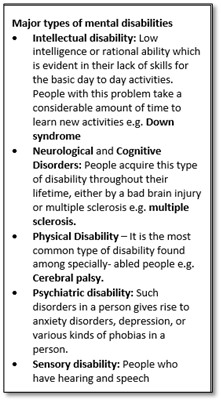
What are the disability laws in India?
According to the Rights of Persons with Disabilities (RPwD) Act, 2016, Disability has been defined based on an evolving and dynamic concept. The Act covers the following specified mental disabilities:-
- Mental retardation: A condition of arrested or incomplete development of mind of a person which is specially characterized by sub - normality of intelligence i.e. cognitive, language, motor and social abilities
- Autism: A condition of uneven skill development primarily affecting the communication and social abilities of a person, marked by repetitive and ritualistic behaviour.
- Multiple Disability: A combination of two or more disabilities such as Blindness/low vision Speech and Hearing Impairement Locomotor disability including leprosy cured Mental retardation and Mental illness
Way Forward
- Mental disabilities are among the leading causes of non-fatal disease burden in India, but a systematic understanding of their prevalence, disease burden, and risk factors is not readily available for each state of India.
- There is need to take institutional and legal actions to protect persons with disabilities and the judgement of Supreme Court on disciplinary proceedings is a step in the right direction.
- Surveys, investigations and research shall be conducted to ascertain the cause of occurrence of disabilities.
- Reservation and promotion benefits be followed properly. Unemployment allowances can be provided to educated persons with disabilities.
- Facilities of wheel chair accessible in all public spaces. Aids and Appliances shall be made available to the people with disabilities.
- Institutional mechanism for grievance Redressal
Sources:
Statehood for Ladakh
In News
A complete shutdown is being observed in Ladakh to press for the demand of statehood for the region.
About the news
- Ladakh was carved out as a separate union territory in August 2019 after Article 370 was read down by Parliament.
- Recently, the UT has observed complete shutdown demanding for restoration of statehood and implementation of the sixth schedule of the Constitution to safeguard their identity, culture, land and jobs.

Ladakh’s Demand
- Four major demands: The UT has four major demands that include:
- Statehood for Ladakh
- Protection under Sixth Schedule of the Constitution
- Filling of 12,000 vacancies and
- Allocation of two Lok Sabha seats and one Rajya Sabha seat.
- Why Constitutional Safeguards? The Constitutional safeguards which can be done by amending the Ladakh Autonomous Hill District Council (LAHDC) Act would clarify the role and responsibilities of the Ministry of Home Affairs (MHA), Lieutenant Governor, urban and rural panchayats vis a vis the two councils of Leh and Kargil.
- Other Demands: A demand is being made for protection of employment and cultural identity of Ladakh under the Sixth Schedule.
- The sixth schedule in the Constitution protects tribal populations, providing autonomy to the communities through creation of autonomous development councils.
- These councils can frame laws on land, public health, agriculture etc. Currently, 10 autonomous councils exist in Assam, Meghalaya, Tripura and Mizoram.
What are the Stated Grievances of the UT?
- Vulnerability due to reading down of Art 35A: The protection provided to the UT through Article 35A has suffered a major setback due to the fact that it was read down along with Article 370.
- No Government Recruitment: Since 2019, there has been no government recruitment even though several persons have retired and the administration had claimed there were more than 20,000 vacancies.
- Large scale acquisition of Land due to misconceptions: Thousands of acres of land are being acquired for solar power projects considering them unused. But these lands are found to sustains wildlife, medicinal herbs and there are migration of nomads in the region.
- This is because there is no constitutional provision (6th schedule of the Constitution) that authorizes the Councils to make laws on the judicious utilization of State land.
- Environmental concerns over Pangong Lake: The area around the Pangong Lake that so far allowed only tented accommodations, now permits the outside to exploit the area for infrastructural development which will not only destroy the environment but will also lead to haphazard development.
- Holding of Resident Certificate: The Resident Certificate is issued only to the Permanent Resident Certificate holders of the Ladakh region, unlike J&K where new domicile laws allowed outsiders too to apply for jobs and purchase land.
- Strategic Concerns: As Ladakh shares its border with China, it has great strategic importance. Empowering the region with District Autonomous Councils that is elected by the people could provide grass root decision making in matters relating to land.
- Absence of Democratically elected Government: Absence of a democratically elected government in Ladakh seem to make people disempowered.
Source:
International Human Solidarity Day
On December, 2005, the General Assembly by revolution 60/209 recognized solidarity as one of the fundamental and universal values of the twenty-first century. Solidarity is identified in the Millennium Declaration as one of the fundamental values of international relations in the 21st Century, wherein those, who either suffer or benefit least deserve help from those who benefit most. Consequently, in the context of globalization and the challenge of growing inequality, strengthening of international solidarity is indispensable. Therefore, the UN General Assembly, convinced that the promotion of the culture of solidarity and the spirit of sharing is important for combating poverty, proclaimed 20 of December as International Human Solidarity Day. Through initiatives such as the establishment of the World Solidarity Fund to eradicate poverty and the proclamation of International Human Solidarity Day, the concept of solidarity was promoted as crucial in the fight against poverty and in the involvement of all relevant stakeholders.
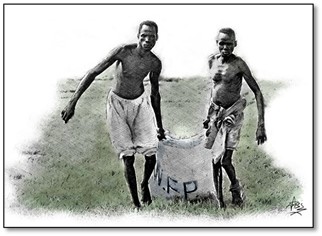
Source:
Second Demographic Dividend
In News
The renaming of the National Action Plan for Sr. Citizens (NAPSrC) as Atal Vayo Abhyuday Yojana, indicates a step towards reaping the benefits of the Second Demographic Dividend.
What is Second Demographic Dividend (SDD)?
- About SDD: This second demographic dividend is characterized by an accumulation of wealth and savings as older individuals save for consumption at old age and invest in their human capital, especially in health and education.
- Difference between 1st and 2nd Demographic Dividend:
- The first dividend occurs during the demographic transition process, when the working-age population increases as a share of the total population, and the percentage of both young and old dependents decreases.
- The second demographic dividend results from an increase in adult longevity, which causes individuals to save more in preparation for old age.

India’s Demographic Profile
- India’s population is stabilising, as the total fertility rate (TFR) has decreased across majority of the states, as per the NFHS-5
- As of 2019, over 139 million people living in India are aged over 60 which is over 10% of the country’s total population. The proportion of older people is expected to almost double to 19.5% in 2050 with 319 million people aged over 60. This means that every 1 in 5 Indians is likely to be a senior citizen.
- The proportion of participation in economic activity by the elderly person in the age-group 60-64 years has decreased from 49.3% in 2011-12 to 40.9% in 2018-19. Similar trend has also been noticed for the age group 65 years and above.
- Literacy levels among elderly males and females have improved over time in both rural and urban areas. However, huge gender gap has been observed in literacy rates
- The rise in the elderly population may be due to the longevity of life achieved because of economic well-being, better healthcare and medical facilities and reduction in fertility rates.
What is the potential of SDD?
- Economic Potential: This second dividend operates in two ways:
- Greater Accumulation of Wealth: People accumulate wealth during their working years, and by the time they reach old age their wealth is at or near its peak. Also, as people realize they will live longer, they will be more motivated to accumulate wealth that they can use to support themselves in old age.
- Greater Investments in Human Capital: As people’s wealth increases, research indicates that they are more likely to invest in the health and education. With fewer children to care for, it is possible for parents to invest more resources in each child.
- If countries are forward-looking and act early, the opportunities the longevity dividend provides can potentially lead to improved productivity over longer lifespans and an increase in gross national income.
- Social Potential
- Less Dependency Ratio: SDD can lead to healthier old age individuals, who are financially independent. This is lead to savings for government as the support infrastructure for elderly would reduce.
- Better Mental being: With lifetime of experience and robustness due to difficult situations, SDD can lead to growth in better mental health among individuals and create and over all ripple effect on the society.
- Knowledge Base: Intergenerational work is a great way to break down barriers between groups of people. For young people to appreciate the experiences and skills of older people and vice versa so that we foster greater understanding between groups of people.
What can be the Challenges realising this potential?
- Strain on Public Exchequer: As India witnesses sustained periods of growth, a significant part of the population is expected to live longer than ever before. This essentially would mean that the dependency on the national pension system would be longer after they exit the labour market, adding pressure both on the government and the senior citizens.
- Societal Barriers: Older people are mostly seen as a bundle of problems and service-needs. Their strengths, skills and knowledge are not harnessed or appreciated in a society infatuated by the youth. Exacerbated risks for women across their life make them more vulnerable in old age.
- Economic Barriers: India is rated 130th out of 189 countries on the latest United Nations Human Development Index Ranking in 2018. Only a quarter of people (24.1%) older than the statutory pensionable age in India receive an old-age pension.
- High Dependency ratio: There is a significant increase in the old-age dependency ratio in India, which rose from 10.9 per cent in 1961 to 14.2 per cent in 2011 and is projected to increase to 15.7 per cent and 20.1 per cent in 2021 and 2031, respectively.
- Health Barriers: Older people need care and support. An ageing population increases the demand for health services. Most common disability among the aged persons was locomotor disability and visual disability as per Census 2011.
- Administrative: Despite concerns about the fiscal pressures of ageing on the economy, the reality is that our income support systems in their current form are not even capable of catering to the elderly when their proportion of the population is only 8.6%.
- Amidst the rise in the number of senior citizens in the country, interest rates on savings are falling and touching an all-time low.
Way Forward
Steps taken by government for SDD: Refer to the snapshot on ‘Elderly in India 2021 Report’ (https://edukemy.com/current-affairs/gazette/2021-08-11/elderly-in-india-2021-report)
- Transfer Wealth: As an alternative to accumulating assets individuals or governments may accumulate transfer wealth,e., claims against future generations. Governments can establish transfer programs in which, pension benefits of current retirees are paid by taxing current workers.
- Life-long Learnings: Singaporean government has invested significantly in life-long learning initiatives to boost society’s human capital potential as well as to promote personal development and social integration.
- Skill Development: There is need to for creating Skill sets for the future among the young populace and re-skill the older populace to capitalize on their potential.
- Social risk pooling: Individuals tend to have great difficulty hedging longevity risk, which includes the risk of outliving their retirement resources and catastrophic health shocks. Relying solely on individual efforts to finance old-age consumption may thus accentuate income and wealth inequalities in society. Here, mechanisms such as social risk pooling can help.
- Robust and Accessible Financial Systems: Policymakers, especially in developing countries, need to establish sound and trusted financial systems accessible to the millions who wish to secure their financial futures. This could serve to protect the country from an excessive healthcare burden as the population ages.
- Increasing Retirement Age: While in India, the age for retirement in a majority of government-owned institutions is 60, there are economies like Germany, the US, the UK, Australia, China and Japan that are progressively increasing their retirement age. This will help utilise the experience and knowledge of those at the top for a few more years.
- Another benefit of raising the retirement age would be the government’s ability to reduce the burden of paying for pensions.
Question: The Second Demographic Dividend can create inter-generation benefits, if capitalized well. Discuss.
Sources:
First true millipede
This is image of the first true millipede, which has been discovered by scientists in one of Australia's mining regions. The blind millipede has an impressive 1,306 legs - the most legs for any known animal ever. The pale-coloured millipede is 3.5 inches (95 mm) long and 0.95 mm wide. Possessing a "conical head" complementing its "beak-shaped mouth" and large antennae, the first true millipede of Earth is unfortunately blind. In the absence of eyes, the creature called "Eumillipes persephone" uses its large antennae as its only source of sensory input. Even though organisms were previously also categorised as millipede, no actual organism with over 1,000 legs was found. Even though organisms were previously also categorised as millipede, no actual organism with over 1,000 legs was found.
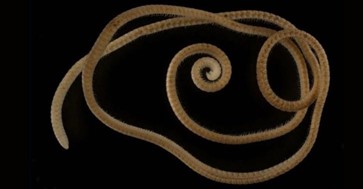
Source:
India’s largest foreign exchange reserves
- Context: Ministry of Finance has recently stated that India currently has the fourth largest foreign exchange reserves in the world.
- The forex reserve stood at USD 640.4 billion as on November.
- Regarded as the health meter of a country, Foreign Exchange reserves or Forex reserves are assets that include foreign currencies, gold reserves, treasury bills, etc retained by a central bank or other monetary authority.
- RBI is the custodian of the Foreign exchange reserves in India.
- The biggest contributor to this reserve is foreign currency assets followed by the gold, SDR, and reserve with the International Monetary Fund.
- Purpose of the Foreign Exchange Reserve:
- It ensures that RBI has backup funds if the national currency rapidly devalues or becomes altogether insolvent.
- A good stock of forex creates a good image at the international level among trading partners and helps in attracting foreign trade.
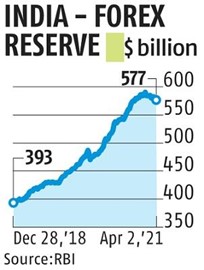
Source:
Commissionerate system
- Context: Madhya Pradesh Chief Minister has announced the implementation of a police Commissionerate systems in Bhopal and Indore.
- Under the currently prevailing dual command system in the state, the District Magistrate and the Superintendent of Police (SP) share powers and responsibilities in a district.
- The DM is entrusted with issuing arrest warrants, licenses while the SP has powers and responsibilities to investigate crime and make arrests which ensures a lower concentration of power, making the police more accountable to the DM at the district level.
- Under the police commissionerate system, the powers of both policing and magistracy are concentrated with the commissioner, who is directly accountable to the state government and the state police chief.
- This means that such police officers now have powers of preventive arrest, imposing Section 144 of the CrPC Act also conduct externment proceedings and issue written orders to remove a person from their jurisdiction of the commissionerate for a maximum of two years.
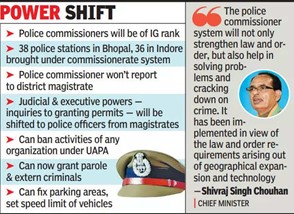
Source:
Facial recognition at airports from 2022
- Context: From March 2022, passengers will be able to use a face scan as their boarding pass at four airports in the country.
- Airports at Varanasi, Pune, Kolkata and Vijaywada will be the first to roll-out the facial recognition technology-based biometric boarding system.
- Like all biometrics solutions, facial recognition technology measures and matches the unique characteristics for the purposes of identification or authentication.
- Often leveraging a digital or connected camera, facial recognition software can detect faces in images, quantify their features, and then match them against stored templates in a database.
- The Airports Authority of India has engaged NEC Corporation Private Limited for implementing the technology as part of the DigiYatra policy, which seeks to promote paperless air travel and a seamless journey from entering an airport till boarding a plane.

Source:
‘VIHANGAM’
- Context: ‘VIHANGAM’ integrated with a Remotely Piloted Aircraft System (RPAS) at Mahanadi Coalfields Limited (MCL) was inaugurated recently.
- It is an internet-based platform that enables real-time transmission of aerial video of mining activities from mines to internet platform which can be accessed through VIHANGAM portal by authorized personnel only having ID and password.
- The system consists of a Ground Control Station (GCS), an RPAS, internet lease line of 40 Mbps and VIHANGAM portal.
- It has been deployed at two opencast mines of MCL.
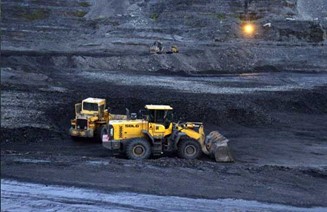
Source:
Can India become a technology leader?:TH
Essence: The article highlights the fact that India, despite of having celebrated technologists, is still not a major player in the technology sector. The reason of its failure is its inability to channelize the use of the market-driven growth opportunities. The lack of investment on part of the government along with poor achievement in school education also adds up to this.
In order to improve the situation India needs to improve the public spending in the quality of higher education. Along with that it should gear up its production in electronic goods and components so as to reap the benefits of India achieving twice the number of internet users as in US which provides large market for all kind of technologies. Last but not the least, the public sector in India should be evaluated on the basis of long term contributions and potential to create opportunities for private sector.
Why you should read this article?
- To understand the reason why India is lacking behind on technological front?
- To understand the success stories of countries like US and China.
- To understand the steps India should take to improve its situation in this area.
Source:
Sri Lanka: ‘Internationalising’ fisheries issue with India will have consequences- ORF
Essence: The editorial talks about the issue of poaching by Indian fishermen in Sri Lankan waters and in return, Sri Lanka internationalizing this issue with USA. There are many issues with such a Sri Lankan stand. Firstly, bilateral issues have been dealt with, through SoP between MEA, GoI and Sri Lankan Navy or SL government. Secondly, whether the Fisheries Minister had the support of Sri Lankan govt (PM/President) before bringing up the issue with USA is another question. Thirdly, it opens up questions of wider dimensions of history and boundary between both the nations.
The 1974 ‘IMBL agreement’ between the two nations delineated the ‘international maritime boundary line’ and later agreements exempted the use of median line to determine the IMBL, and accepted deviations agreed to by the stakeholder-nations. Through this, the Katchchativu islet, which was closer to Indian side, was passed to Sri Lanka. SL Naval boats approaching the island and refusal to Indian fishermen to fish in the region irked the Tamil politicians. Poll promises were made to take the islet back and it has become an irritant in the region.
Next, the 1974 agreement ensured that the Palk Strait was made “a bilateral pond”, rather than a region of international transit. If the issue is further internationalized, it could be to the jeopardy of both the nations that USA asks for freedom of navigation operations (FONOP) at Palk Bay region. Thus, escalation of such issues could be avoided for the larger welfare of the locals and the 2 nations in focus.
Why you should read this article?
- To understand how Sri Lankan minister has approached the issue of fisheries crisis between India and Sri Lanka.
- To understand the impacts of IMBL agreement and Katchchativu islet exchange and its political impact
- To analyze the role of USA incase the bilateral issue is internationalized.
Source:
Reading sex ratio trends in NFHS-5 data: IE
Essence: The findings of the NFHS-5 on demographic and health indicators has sparked a debate due to lack of proper data interpretation. The finding that there are 1,020 women for 1,000 men, an improvement over the last round of survey, has led to a wide-ranging conversation. But, even nationally representative household surveys, show a similar trend. As a result, using sex ratio trends to argue for India's progress on gender justice and women's empowerment isn't altogether incorrect, while this ratio isn't the only sign of gender equality.
Given the widespread concern about a surveyed population's stated sex ratio, it's important to know the limitations of generalisations and caution against drawing definite conclusions, while simultaneously demonstrating how these surveys might assist understand certain trends. For example, in NFHS 4, a favourable sex ratio was reported for a handful of the states, which was inconsistent with the gender-based developmental indicators. It may be premature to declare India to have a balanced sex ratio, the NFHS findings certainly show improvement in that direction.
Why should you read this article?
- To comprehend why the NFHS-5 data on India's sex ratio trends have sparked such debate.
- Recognize the limitations of generalisations and avoid drawing firm inferences based on a surveyed population's reported sex ratio.
Source:
The Walking Librarian
Background
- Books have always proved to be the source of knowledge, exposure, intelligence, leisure, and completeness for humans.
- P Sukumaran, hailing from Karuvatta in Kerala, has been a walking librarian for the last 41 years.

Dedication of the Walking Librarian
- P Sukumaran is fondly known as ‘walking librarian’, who visits about 35 houses in the Karuvatta and Kumarapuram grama panchayats to deliver books to women and children.
- As the library visits have started becoming sparse, he took the initiative to take library to the readers.
- He walks about 12 km a day for the deliveries.
- His efforts did not decrease even after receiving a meagre salary and having a child who is suffering from autism.
- Sukumaran’s mission is to inculcate the value of books and the habit of reading among with people.
Quote:
Bad libraries build collections, good libraries build services, great libraries build communities. – R. David Lankes
Source:
Share the article
Get Latest Updates on Offers, Event dates, and free Mentorship sessions.

Get in touch with our Expert Academic Counsellors 👋
FAQs
UPSC Daily Current Affairs focuses on learning current events on a daily basis. An aspirant needs to study regular and updated information about current events, news, and relevant topics that are important for UPSC aspirants. It covers national and international affairs, government policies, socio-economic issues, science and technology advancements, and more.
UPSC Daily Current Affairs provides aspirants with a concise and comprehensive overview of the latest happenings and developments across various fields. It helps aspirants stay updated with current affairs and provides them with valuable insights and analysis, which are essential for answering questions in the UPSC examinations. It enhances their knowledge, analytical skills, and ability to connect current affairs with the UPSC syllabus.
UPSC Daily Current Affairs covers a wide range of topics, including politics, economics, science and technology, environment, social issues, governance, international relations, and more. It offers news summaries, in-depth analyses, editorials, opinion pieces, and relevant study materials. It also provides practice questions and quizzes to help aspirants test their understanding of current affairs.
Edukemy's UPSC Daily Current Affairs can be accessed through:
- UPSC Daily Current Affairs can be accessed through Current Affairs tab at the top of the Main Page of Edukemy.
- Edukemy Mobile app: The Daily Current Affairs can also be access through Edukemy Mobile App.
- Social media: Follow Edukemy’s official social media accounts or pages that provide UPSC Daily Current Affairs updates, including Facebook, Twitter, or Telegram channels.


